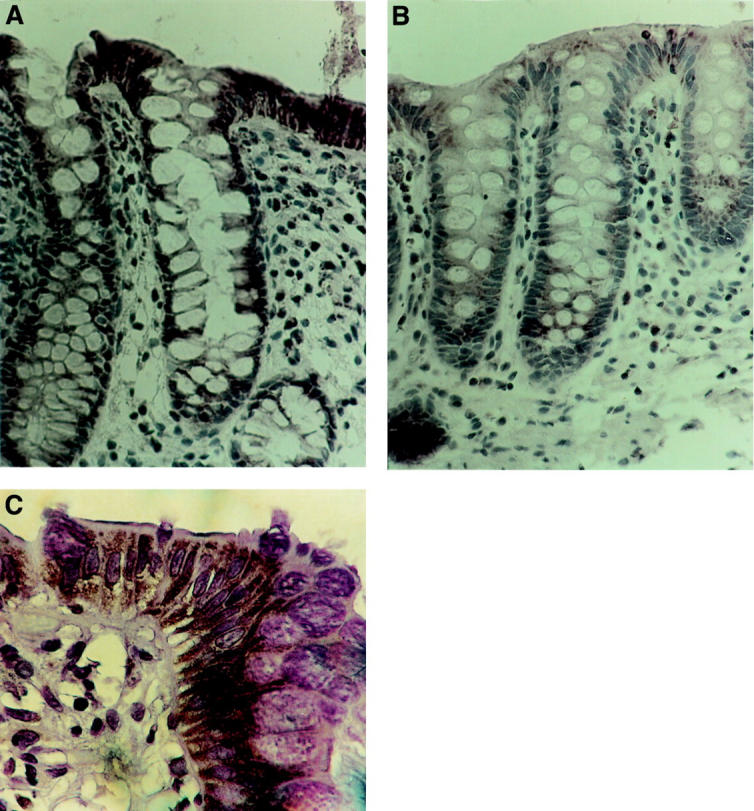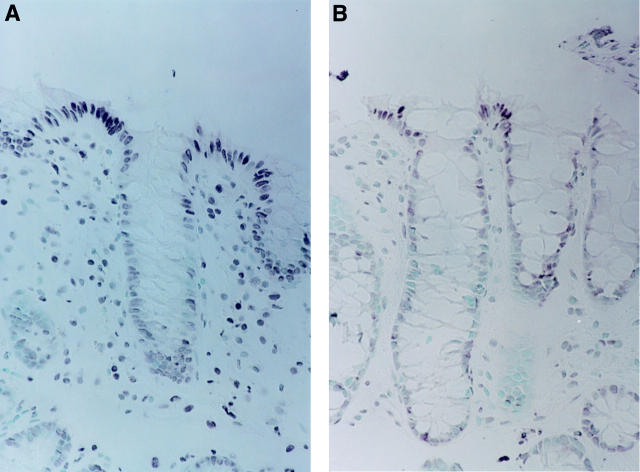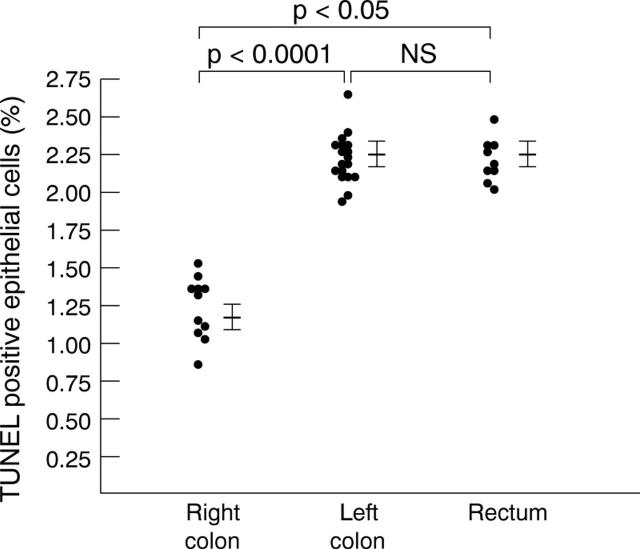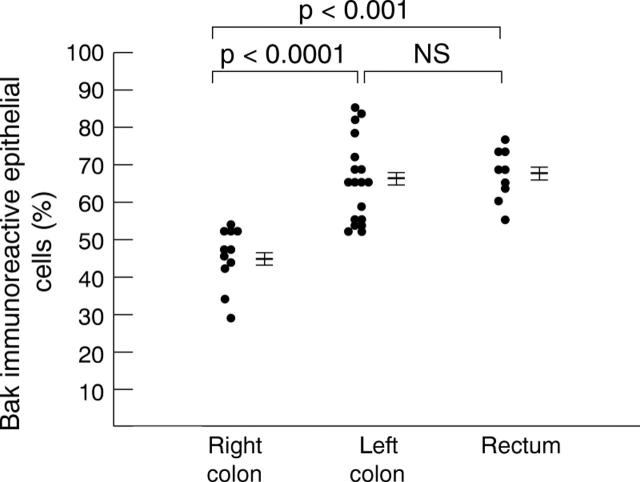Abstract
BACKGROUND—Propensity to colonic neoplasia differs between the right and left colon. AIMS—To examine whether this difference may be related to regional differences in epithelial apoptosis, in expression of a proapoptotic regulatory protein, Bak, and in proliferation. PATIENTS—Individuals with no history of colorectal neoplasia. METHODS—Archival blocks of colorectal tissues were immunostained for proliferating cells (antibody to Ki-67 antigen), and Bak expression (polyclonal antiserum). Cells containing DNA strand breaks, a marker of apoptosis, were identified by terminal deoxyuridine nucleotidyl nick end labelling (TUNEL). RESULTS—There were fewer TUNEL positive epithelial cells in the right colon (mean 1.2 (SE 0.1)% of all epithelial cells) than the left colon (2.2 (0.1)%, p<0.0001) or rectum (2.2 (0.3)%, p<0.05). Bak expression was less common in the right colon (mean 46 (2.3)% of epithelial cells immunoreactive) than the left colon (66 (2.7)%, p<0.0001), or rectum (67 (2.3)%, p<0.001). Bak expression and TUNEL positivity were highly positively correlated (p<0.0001). In contrast to apoptosis, mean whole crypt proliferation labelling index was similar throughout the colorectum (right colon: 15.6 (3.2)%; left colon: 13.5 (1.2)%; rectum: 13.3 (2.3)%). CONCLUSION—The percentage of proliferating colonic epithelial cells is constant throughout the colon, but fewer epithelial cells undergo Bak mediated apoptosis in the right than in the left colon or rectum. This suggests that colonocytes may be lost by methods other than apoptosis in the right colon. Keywords: programmed cell death; Bcl-2; cell cycle; cell proliferation; colon carcinogenesis
Full Text
The Full Text of this article is available as a PDF (176.9 KB).
Figure 1 .
TUNEL staining showing dark, positively stained, nuclei of cells carrying DNA strand breaks at the surface of colonic crypts, more frequent in the left colon (A) than in the right colon (B). Some TUNEL positive cells are also evident in the lamina propria, especially in the left colon. Original magnification ×200.
Figure 2 .
Differences in the regional distribution of TUNEL positive epithelial cells within the colorectum. Individual data points are shown with means and standard errors represented by the bars.
Figure 3 .

Expression of Bak in colonic crypts from left colon (A) and right colon (B). Bak is expressed in the cytoplasm of superficial colonocytes throughout the colon but the immunointensity and percentage of cells staining with Bak antibody is greater in the left compared with the right colon. At higher magnification (C), Bak immunostaining is evident in the supranuclear and infranuclear regions of surface colonocytes. Original magnification ×200 (A,B); ×400 (C).
Figure 4 .
Percentage of Bak immunoreactive epithelial cells in different regions of the normal human colorectum. Individual data points are shown with mean and standard errors shown as bars.
Figure 5 .
Correlation between Bak immunoreactivity and TUNEL positive cells in normal human colonic epithelium.
Figure 6 .
Immunostaining with the Mib-1 antibody to Ki-67 shows the nuclei of proliferating cells in the base of normal colonic crypts from right colon. Original magnification ×200.
Selected References
These references are in PubMed. This may not be the complete list of references from this article.
- Adami H. O. Aspects of descriptive epidemiology and survival in colorectal cancer. Scand J Gastroenterol Suppl. 1988;149:6–20. doi: 10.3109/00365528809096952. [DOI] [PubMed] [Google Scholar]
- Bedi A., Pasricha P. J., Akhtar A. J., Barber J. P., Bedi G. C., Giardiello F. M., Zehnbauer B. A., Hamilton S. R., Jones R. J. Inhibition of apoptosis during development of colorectal cancer. Cancer Res. 1995 May 1;55(9):1811–1816. [PubMed] [Google Scholar]
- Calderó J., Campo E., Ascaso C., Ramos J., Panadés M. J., Reñ J. M. Regional distribution of glycoconjugates in normal, transitional and neoplastic human colonic mucosa. A histochemical study using lectins. Virchows Arch A Pathol Anat Histopathol. 1989;415(4):347–356. doi: 10.1007/BF00718637. [DOI] [PubMed] [Google Scholar]
- Distler P., Holt P. R. Are right- and left-sided colon neoplasms distinct tumors? Dig Dis. 1997 Jul-Oct;15(4-5):302–311. doi: 10.1159/000171605. [DOI] [PubMed] [Google Scholar]
- Garewal H., Bernstein H., Bernstein C., Sampliner R., Payne C. Reduced bile acid-induced apoptosis in "normal" colorectal mucosa: a potential biological marker for cancer risk. Cancer Res. 1996 Apr 1;56(7):1480–1483. [PubMed] [Google Scholar]
- Gavrieli Y., Sherman Y., Ben-Sasson S. A. Identification of programmed cell death in situ via specific labeling of nuclear DNA fragmentation. J Cell Biol. 1992 Nov;119(3):493–501. doi: 10.1083/jcb.119.3.493. [DOI] [PMC free article] [PubMed] [Google Scholar]
- Hague A., Elder D. J., Hicks D. J., Paraskeva C. Apoptosis in colorectal tumour cells: induction by the short chain fatty acids butyrate, propionate and acetate and by the bile salt deoxycholate. Int J Cancer. 1995 Jan 27;60(3):400–406. doi: 10.1002/ijc.2910600322. [DOI] [PubMed] [Google Scholar]
- Hague A., Manning A. M., Hanlon K. A., Huschtscha L. I., Hart D., Paraskeva C. Sodium butyrate induces apoptosis in human colonic tumour cell lines in a p53-independent pathway: implications for the possible role of dietary fibre in the prevention of large-bowel cancer. Int J Cancer. 1993 Sep 30;55(3):498–505. doi: 10.1002/ijc.2910550329. [DOI] [PubMed] [Google Scholar]
- Hall C., Youngs D., Keighley M. R. Crypt cell production rates at various sites around the colon in Wistar rats and humans. Gut. 1992 Nov;33(11):1528–1531. doi: 10.1136/gut.33.11.1528. [DOI] [PMC free article] [PubMed] [Google Scholar]
- Hass R., Busche R., Luciano L., Reale E., Engelhardt W. V. Lack of butyrate is associated with induction of Bax and subsequent apoptosis in the proximal colon of guinea pig. Gastroenterology. 1997 Mar;112(3):875–881. doi: 10.1053/gast.1997.v112.pm9041249. [DOI] [PubMed] [Google Scholar]
- Heerdt B. G., Houston M. A., Augenlicht L. H. Potentiation by specific short-chain fatty acids of differentiation and apoptosis in human colonic carcinoma cell lines. Cancer Res. 1994 Jun 15;54(12):3288–3293. [PubMed] [Google Scholar]
- Ho S. B., Toribara N. W., Bresalier R. S., Kim Y. S. Biochemical and other markers of colon cancer. Gastroenterol Clin North Am. 1988 Dec;17(4):811–836. [PubMed] [Google Scholar]
- Holt P. R., Moss S. F., Kapetanakis A. M., Petrotos A., Wang S. Is Ki-67 a better proliferative marker in the colon than proliferating cell nuclear antigen? Cancer Epidemiol Biomarkers Prev. 1997 Feb;6(2):131–135. [PubMed] [Google Scholar]
- Jen J., Kim H., Piantadosi S., Liu Z. F., Levitt R. C., Sistonen P., Kinzler K. W., Vogelstein B., Hamilton S. R. Allelic loss of chromosome 18q and prognosis in colorectal cancer. N Engl J Med. 1994 Jul 28;331(4):213–221. doi: 10.1056/NEJM199407283310401. [DOI] [PubMed] [Google Scholar]
- Krajewska M., Moss S. F., Krajewski S., Song K., Holt P. R., Reed J. C. Elevated expression of Bcl-X and reduced Bak in primary colorectal adenocarcinomas. Cancer Res. 1996 May 15;56(10):2422–2427. [PubMed] [Google Scholar]
- Kune S., Kune G. A., Watson L. The Melbourne colorectal cancer study: incidence findings by age, sex, site, migrants and religion. Int J Epidemiol. 1986 Dec;15(4):483–493. doi: 10.1093/ije/15.4.483. [DOI] [PubMed] [Google Scholar]
- Lynch H. T., Smyrk T. Hereditary nonpolyposis colorectal cancer (Lynch syndrome). An updated review. Cancer. 1996 Sep 15;78(6):1149–1167. doi: 10.1002/(SICI)1097-0142(19960915)78:6<1149::AID-CNCR1>3.0.CO;2-5. [DOI] [PubMed] [Google Scholar]
- Magnuson B. A., Shirtliff N., Bird R. P. Resistance of aberrant crypt foci to apoptosis induced by azoxymethane in rats chronically fed cholic acid. Carcinogenesis. 1994 Jul;15(7):1459–1462. doi: 10.1093/carcin/15.7.1459. [DOI] [PubMed] [Google Scholar]
- McBain J. A., Eastman A., Simmons D. L., Pettit G. R., Mueller G. C. Phorbol ester augments butyrate-induced apoptosis of colon cancer cells. Int J Cancer. 1996 Sep 4;67(5):715–723. doi: 10.1002/(SICI)1097-0215(19960904)67:5<715::AID-IJC21>3.0.CO;2-2. [DOI] [PubMed] [Google Scholar]
- McIntyre A., Gibson P. R., Young G. P. Butyrate production from dietary fibre and protection against large bowel cancer in a rat model. Gut. 1993 Mar;34(3):386–391. doi: 10.1136/gut.34.3.386. [DOI] [PMC free article] [PubMed] [Google Scholar]
- Moss S. F., Agarwal B., Arber N., Guan R. J., Krajewska M., Krajewski S., Reed J. C., Holt P. R. Increased intestinal Bak expression results in apoptosis. Biochem Biophys Res Commun. 1996 Jun 5;223(1):199–203. doi: 10.1006/bbrc.1996.0869. [DOI] [PubMed] [Google Scholar]
- Moss S. F., Liu T. C., Petrotos A., Hsu T. M., Gold L. I., Holt P. R. Inward growth of colonic adenomatous polyps. Gastroenterology. 1996 Dec;111(6):1425–1432. doi: 10.1016/s0016-5085(96)70003-3. [DOI] [PubMed] [Google Scholar]
- Moss S. F., Scholes J. V., Holt P. R. Abnormalities of epithelial apoptosis in multistep colorectal neoplasia demonstrated by terminal deoxyuridine nick end labeling. Dig Dis Sci. 1996 Nov;41(11):2238–2247. doi: 10.1007/BF02071407. [DOI] [PubMed] [Google Scholar]
- Nakashima T., Seto Y., Nakajima T., Shima T., Sakamoto Y., Sano A., Takino T. Distribution of tissue bile acids in the human alimentary tract and colon polyps. Jpn J Med. 1989 Jan-Feb;28(1):25–29. doi: 10.2169/internalmedicine1962.28.25. [DOI] [PubMed] [Google Scholar]
- Park H. S., Goodlad R. A., Ahnen D. J., Winnett A., Sasieni P., Lee C. Y., Wright N. A. Effects of epidermal growth factor and dimethylhydrazine on crypt size, cell proliferation, and crypt fission in the rat colon. Cell proliferation and crypt fission are controlled independently. Am J Pathol. 1997 Sep;151(3):843–852. [PMC free article] [PubMed] [Google Scholar]
- Ponz de Leon M., Roncucci L., Di Donato P., Tassi L., Smerieri O., Amorico M. G., Malagoli G., De Maria D., Antonioli A., Chahin N. J. Pattern of epithelial cell proliferation in colorectal mucosa of normal subjects and of patients with adenomatous polyps or cancer of the large bowel. Cancer Res. 1988 Jul 15;48(14):4121–4126. [PubMed] [Google Scholar]
- Potten C. S. What is an apoptotic index measuring? A commentary. Br J Cancer. 1996 Dec;74(11):1743–1748. doi: 10.1038/bjc.1996.624. [DOI] [PMC free article] [PubMed] [Google Scholar]
- Reed J. C. Double identity for proteins of the Bcl-2 family. Nature. 1997 Jun 19;387(6635):773–776. doi: 10.1038/42867. [DOI] [PubMed] [Google Scholar]
- Singh B., Halestrap A. P., Paraskeva C. Butyrate can act as a stimulator of growth or inducer of apoptosis in human colonic epithelial cell lines depending on the presence of alternative energy sources. Carcinogenesis. 1997 Jun;18(6):1265–1270. doi: 10.1093/carcin/18.6.1265. [DOI] [PubMed] [Google Scholar]
- Strachan JD, Bitter M, Ramsey AT, Zarnstorff MC, Arunasalam V, V, Bell MG, Bretz NL, Budny R, Bush CE, Davis SL. High-temperature plasmas in a tokamak fusion test reactor. Phys Rev Lett. 1987 Mar 9;58(10):1004–1007. doi: 10.1103/PhysRevLett.58.1004. [DOI] [PubMed] [Google Scholar]
- Sunter J. P., Watson A. J., Wright N. A., Appleton D. R. Cell proliferation at different sites along the length of the rat colon. Virchows Arch B Cell Pathol Incl Mol Pathol. 1979 Dec;32(1):75–87. doi: 10.1007/BF02889015. [DOI] [PubMed] [Google Scholar]
- Terpstra O. T., van Blankenstein M., Dees J., Eilers G. A. Abnormal pattern of cell proliferation in the entire colonic mucosa of patients with colon adenoma or cancer. Gastroenterology. 1987 Mar;92(3):704–708. doi: 10.1016/0016-5085(87)90021-7. [DOI] [PubMed] [Google Scholar]
- Thompson C. B. Apoptosis in the pathogenesis and treatment of disease. Science. 1995 Mar 10;267(5203):1456–1462. doi: 10.1126/science.7878464. [DOI] [PubMed] [Google Scholar]







